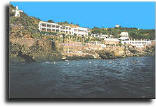|
Ustica
is an isle and is 66 km. far from Palermo which province it belongs to.
The municipality has 1.370 inhabitants and an area of 809 hectares for a density of population of 169 inhabitants per square kilometre. It rises on flat area and is 238 metres above sea-level. In the agricultural field is important the production of cereals, grapes,
vegetables, legumes, prickly pears, lentils. Considerable is fish
production of various sorts of fish which is very important for insular
economy. Typical are craftmade embroideries. The first name of Ustica was Osteodes that in Greek means
ossuary and it was so defined because there have been found skeletons
of 6.000 Carthaginan soldiers. Then the isle was peopled by Romans who
called it Ustum that means burned because of its black
volcanic cliffs.
In the artistical field there are a Bourbonic fortress of the XVIII century and the Torre di S. Maria (Tower of St. Mary) built to defend the homonymous bay. In 1987 was established a Sea Reserve to preserve sea that surrounds the isle which is rich in flora (where stands out the Posidonia oceanica defined like "lungs of Mediterranean" for its important characteristic to turn oxygen into water) and sea fauna. The reserve is divided into three areas A area of complete reserve; B area of general reserve; C area of partial reserve. Typical is the "round on boat of Ustica", organized by local people. During the trip it is possible to visit several grottoes scattered all over the isle. |

